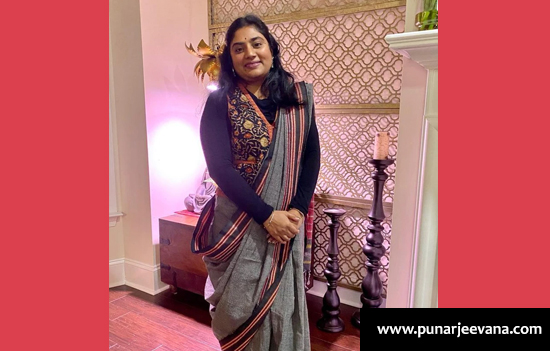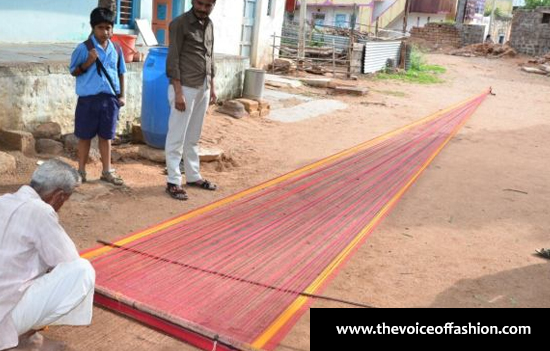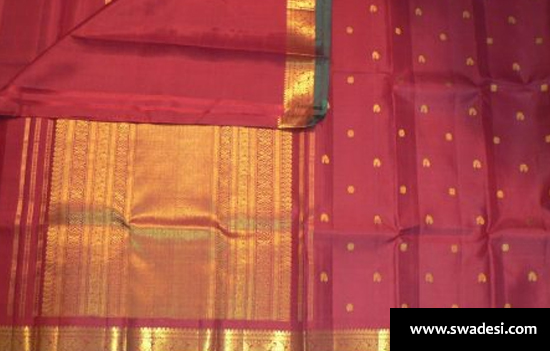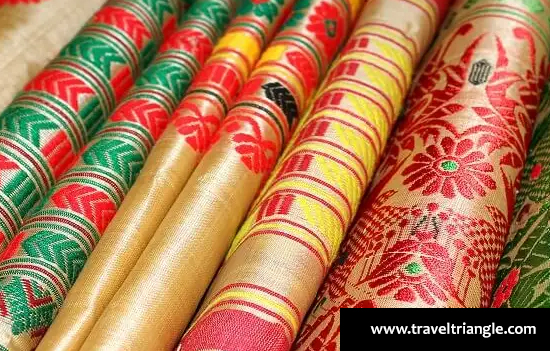- Like
other states Karnataka has a rich handloom sari tradition. This article tells
about Ilkal, Mysore Silk, Gomi teni, Pattenda anchu, Molakalmuru, Udupi and Dharwad
traditions.
1. Ilkal Sari
Ilkal
is a town in Bagalkot district in North Karnataka. It is famous for its unique
style of saree that is popular in Maharashtra too to the extent that it has
been adopted as the typical Maharashtrian saree.
The
design of Ilkal sarees is fairly basic. A colored body (which may be plain or
with checks) with contrasting borders and pallu, usually in darker colors.
Common colors for the borders and pallu are red/maroon, dark blue, and green.
Body colors consist of green, red, black, blue, and sometimes yellow. The pallu
consists of two or three off-white stripes, several inches in width, alternated
with whatever colors that the borders are in.
The
distinctive feature of Ilkal saris is the use of a form of embroidery
called Kasuti. The designs used
in Kasuti reflect traditional patterns like palanquins, elephants and lotuses
which are embroidered onto Ilkal saris. These saris are usually 9 yards in
length and the pallu of the Ilkal sari (the part worn over the
shoulder) carries designs of temple towers. This pallu is usually made of
red silk with white patterns. The end region of the pallu is made up of patterns
of different shapes like hanige (comb), koti kammli (fort
ramparts), toputenne (jowar) and rampa (mountain range).
The
border of the sari is very broad (4 to 6 inches), red or maroon in colour
and is made of different designs with ochre patterns. The sari is either made
of cotton, or a mixture of cotton and silk or in pure silk. The colors
traditionally used are pomegranate red, brilliant peacock green and parrot
green. The saris that are made for bridal wear are made of a particular colour
called Giri Kumukum which
is associated with the sindhoor worn by the wives of priests in this
region.
Types of Borders
The
design woven in the length wise borders are mainly three types. Gomi (more
popularly known as Ilkal dadi), Paraspet (sub-divided into chikki paras and
dodd paras), Gaadi and Jari.
Main Body design
This
consists of Stripes, Rectangles and Squares.
Other Differences
With
the above broad parameters the Ilkal saris differ in matter of size, nature and
quality of yarn used for different portions of a sari as also colour
combination and combinations of designs on the borders and main body of the
sari. The beauty of Tope-teni seragu is further enhanced at times by weaving in
its middle portion, yet another design known as Kyadgi.
Production
Weaving
of Ilkal saris is a household enterprise that has active participation of
female members. It takes about seven days to weave a saree when handloom is
used.

Credits
and good read
To see Video
on Ilkal Saree
(5 minutes)
Album of
village visit where sarees made
2. Mysore Silk
Mysore
silk is known for its unique texture more than design. It is relatively light
and easy to drape, similar to chiffon fabrics in nature. Indeed, with Karnataka
being among the leading states for sericulture in India, it is hardly
surprising that it is home to a significant silk weaving industry even though
this is less widespread than cotton weaving. (with China getting into
sericulture I do not know how much of Mysore silk used is local).
Mysore
silk sarees are relatively simple in design, typically featuring zari borders
and stripes in the pallu, with the typical examples having the borders and
pallu dyed in contrasting colors to the body. Unlike Ilkal sarees Mysore silk
sarees do not have the borders woven separately, but rather are dyed in such a
way that the borders and pallu contrast with the body. There are some examples
in solid colors.

Reference or Here
To see Video of Mysore
Creepe Saris
3. Gomi Teni
This
cotton sari was popular in the 12th century. As the motif used on the saris was
the gomi teni or jowar stalks (closely resembling the herringbone pattern), it
was considered a symbol of prosperity and was gifted to pregnant women and worn
during the harvest festival, Sankranti.
Handwoven
on frame looms, the saris bear checkered patterns in contrasting shades. For
instance, a black sari has been contrasted with white checks. The colour
combinations are contemporary. Traditionally the colours used were
predominantly red and yellow.
Gomi
Teni sari does have the motif of the sari resembling a jowar, the crop. It
symbolises prosperity.

Credits
4. Patteda Anchu
Patteda
anchu saree was woven in and around the villages of Gajendragarh, Belgaum,
Raichur, Kodal, Bidar, Bellary, Gulbarga and Dharwad in the 10th Century.
This saree is named after its border and checks pattern but is also known as
dundina seere, devaru seere, laxmi seere or pooja seere.
Made in cotton, it was specifically designed for women working in farms, being only 38” wide and 6 yards in a coarse 20’s count.
The
saree has a specific colour palette including mustard, maroon, pink and
green. As the saree is offered to goddess Yellamma
Saundatti, the local deity of Gajendragarh village, the colour black is not
used.
Patteda
anchu wedding saris are normally woven in shades of red checks with broad
mustard border and is considered very auspicious. The present collection is
made of mill made yarns dyed with eco-friendly dyes woven on handloom. This
collection was executed to reach mass and give sustainable work to artisan.
Patteda
Anchu sarees are handwoven from the handloom hub of Gajendragarh, Karnataka.
The villages in and around the hub are equipped with hand weaving. This
traditional saree has been revived with special features like the reversible
nature of the saree and the specially engineered border which is already coarse
and does not require additional fall or beading to be done, making this a ready
to drape saree.
Traditionally,
the colour format of the sari was red and chocolate brown with a yellow border.
It took me more than six months to convince the weavers to use the colour
black. We also increased the body width to 45 inches. The technicalities
remained more or less the same and the colour weave effect was done with plain
weave. One tries to keep it as authentic as possible, and of late, the entry of
power looms weaving the same saris have altered the patterns - the checks
mostly.

Credits, also read
To see Video of Pattedu
Kanchu Cotton Saris
5. Molakalmuru Saree: A Traditional
Beauty Made in Karnataka!
The exquisite Molakalmuru Sari saree derives its name from the town that it originated and is woven in. Situated in Chitradurga district it is about 245 kms from the state’s capital Bengaluru.
The
fabric used provides it with a particularly desirable texture. These sarees are
made from pure silk with the mulberry variety being used prominently
throughout. Additionally zari is utilized
in the making of the saree i.e. procured from Surat.
These
sarees possess intricate and elegant designs upon them which are also commonly
referred to as motifs. They have varied themes, mostly derived from nature,
such as floral prints, animals, the wilderness, fruits and birds.
Apart from these, geometric and symmetrical patterns are also quite popular in today’s era.
Molakalmuru
sarees give off an ethnic aura and traditional impression which truly makes one
feel closer to their culture as well as heritage and how can one forget the
pallu i.e. truly magnificent. Furthermore, the zari border is another
unmissable element of these sarees as it presents a contrast to the saree and
simply stands out. It is also worth noting that the color of the pallu also
differs from the body of the saree. These sarees are mostly dark colored with
widely used colours being blue, pink, black, green, mustard, red, and more.
The
fabrication of these sarees is done by utilizing traditional handlooms or pit
looms with a fly and a throw shuttle. For this they use chiefly two techniques,
the first being Kuttu. This elaborate
technique requires hard work as it involves manually interlacing the border and
the body of the saree by the use of a total of three throw shuttles: one for
the body, one for the border, and another one for the pallu. The second one is
the Chalu Technique, which involves
joining the existing and new warp ends of the pallu. The coloring of these
sarees requires the use of the tie and dye method. By the application of these,
a single Molakalmuru Saree is made within approximately eight days.

Credits and read
6. Udupi Saree
Traditional
Udupi saree is one of the richest variety of cotton sarees in Karnataka.
Handwoven Udupi sarees show incomparable versatility of skilled hands that
create them. They are woven in Frame looms, also known as Malabar looms. Sarees with plain solid border, extra warp and
cross border designs add to its uniqueness. The checks sarees with golden or
silver threads with contrasting pallu and border strengthens its aesthetics and
richness.
The Udupi Saree Weavers have begun to weave their magic again!
From a thread of colour is woven a saree that shines. That’s how a saree was traditionally woven – by hand through a loom that was rocked like a mother rocks the cradle that holds her child – with love and a benevolent smile as her loom gently weaved the saree that another would wear.
The weaver’s hand is fundamental to fabric creation: punctilious attention to design, selection of the precious yarns and precise workmanship are the elements that set its quality apart and make all such products exclusive examples of artisan excellence.
The
Udupi handwoven saree is one of the finest examples of hand weaves in the country. It is rich in texture and in culture. The saree has a varied combination of vivid bright colours on the border and the pallu, made from natural dye or starch for the colour, with yarn. The combed cotton yarn is then used to make the saree consisting of counts 80” to 60” (higher the count, more the thickness and the softness of the saree). It is purely hand woven on a hand-driven loom.
The origin of weaving in Udupi
The history of Udupi sarees traces its roots to the Malabar frame looms that were bought by the Basel Mission. (They started industrial training in weaving in south India in the 1840s). Today they are barely a part of our society. It was also a part of the Swaraj movement – the boycott of western goods.
Handlooms are not just traditional to our culture, but also a livelihood for our forefathers. There is a lesson to be learnt too. In the words of John Piper, “We look at life from the backside of the tapestry. And most of the time, what we see is loose threads, tangled knots, and the like. But occasionally, God’s light shines through the tapestry, and we get a glimpse of the larger design with God weaving together the darks and lights of existence.”
What's Special
These handloom sarees are made with combed cotton yarn of counts 80"and 60" for weft. The speciality of Udupi Sarees is that the pallu and borders are bright.
The pallu is dyed in dark shades before weaving and extra weft designs are
woven in attractive colours. For the warp, a tie and dye method is always
vividly applied. First, the entire warp of the sari is dyed with one colour and
for pallu another type of dye is applied.
The practice of 'loom sizing' is used with natural starch solution applied to warps to strengthen the yarn. The sizing material is directly applied to the yarn while weaving is in progress.

Where to shop in
Udupi
Site shows u different type of sarees
To see video on Udupi Sari
Making
Udupi Handloom Sari by
Bindu Lakshmi
7. Kasuti: Dharwad Saree
Originating
from Dharwad this pure handloom cotton collection features its signature
cross-stitch embroidery called Kasuti.
Synonymous with a plain body and a subtle, contrasting border, these sarees
have evolved with changing times. They are hand-woven with exquisite
embroidered motifs and are available in a myriad range of palettes and
patterns.
Dharwad
has sparked interest in cotton creations of a new kind. The cotton
yarn is itself coloured due to path breaking experiments that have developed
these colour cottons. Grown without genetic modification, these cottons are
available in natural colours of brown in light and dark shades.
The speciality of Dharwad Cotton
Sarees
The
pure handloom cotton sarees from Dharwad are soft, fine variety
cottons in several natural colours. The Dharwad cotton saree is known for its
attractive border and appealing floral print designer pallu or end piece. The
introduction of Kasuti, the intricate embroidery of the royal courts in
Karnataka for cotton fabrics stands out very nicely for the colours chosen, the
thread work art and the complex stitching. In addition, the borders are very
appealing with plain multi-colour or temple design patterns chosen.
Dharwad
cotton sarees have rich pallu and the border of the sari is decorated with zari
designs. The cotton saris are rich in colours and hues. These sarees are airy,
comfortable to wear and light in weight. They have many motifs, patterns,
geometrical patterns and zari buttis.
One
of the most popular fabric is Dharwad silk. It is a well-known place for
traditional and pure silk sarees. Cotton sarees are apt for daily casual and
summer wear. Dharwad is well-known for traditional, pure silk and pure cotton
sarees. Dharwad cotton sarees are durable and fine cotton cloth is available in
an amazing range of traditionally authentic styles.
These sarees have all over geometric stair step ornaments on the ground and
bold zari border.
The
black and light grey with green dharwad cotton sari has alternate black and
light grey horizontal bands with zari embroidered buttis and a green patch
border on the blouse. The plain green cotton sari is a fitting contrast. The
green dharwad cotton sari has a white floral embroidered border and black
horizontal stripes on it. This pleasant piece can be used for office,
festivals, social events and even casual outings.
The
dharwad cotton sari has a unique feature. This fabric goes with any Indian
woman. The orange colour poly cotton sari has cut work and green block prints
along with chamki work on the blouse. The sari is an orange self-colour floral
affair in block prints. The orange with brown and red floral prints at the ends
makes it a stylish combination.
This
piece would work well for almost any occasion. Some of these sarees have large
zari temple motif border and graphic pallu. Dharwad cotton sarees are famous
for their unique and traditional designs. These sarees are available in
different colors with different combinations. Incredibly fine thread work will
astound you.
These
sarees are suitable for festivals, such as Diwali, Holi, Dussehra and Pongal
traditional occasions and wedding ceremonies. Designer Dharwad cotton sarees
are apt for any family gatherings, Parties and Bridal functions.

Credits
and see Dharwad Cotton Saris
To
see various sari designs
Good
collection of Handloom Cotton Saris
To see video of Cotton Silk
Saris
The
purpose of this compilation is to document and promote. We have given credits
and reference links in this compilation along with third party links (to
promote). In case some are missed, it is not with malafide intent. Please
email full details to esamskriti108@gmail.com
and we shall effect the change.
To read all
articles by author
To
read all articles on Traditional Textiles of India
Author Trishna
Patnaik
is a self-taught
artist based in Mumbai, Trishna has been practising art for over 14 years. She
is now a full-time professional painter pursuing her passion to create and
explore to the fullest. She conducts painting workshops across India. She is
also an art therapist and healer who works with clients on a one to one basis.
Not to forget her quality writings on Indian Art and now Textiles for
esamskriti. She fancies the art of creative writing.